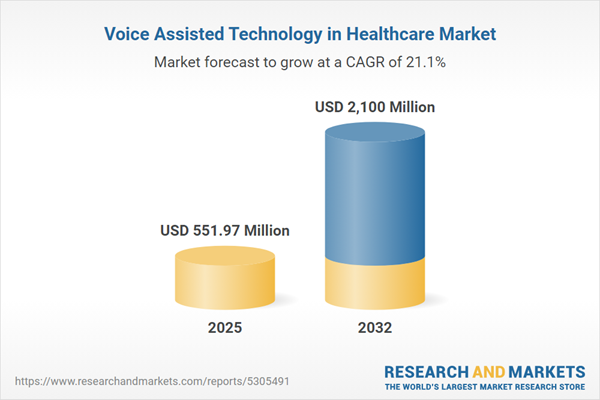Speak directly to the analyst to clarify any post sales queries you may have.
Voice assisted technology in healthcare is rapidly transforming organizational workflows, supporting digital transformation, and enabling senior decision-makers to drive greater efficiency and patient engagement. The adoption of advanced voice-enabled platforms allows clinical teams to streamline communication while enhancing compliance and organizational agility. These evolving solutions are increasingly integral for healthcare providers navigating complex digital demands.
Market Snapshot: Voice Assisted Technology in Healthcare Market
The voice assisted technology in healthcare market reached USD 456.56 million in 2024, with projections to USD 551.97 million for 2025 and an anticipated rise to USD 2.10 billion by 2032, at a CAGR of 21.05%. This robust growth is driven by continuous advancements in artificial intelligence and natural language processing, expanding reliance on scalable cloud infrastructure, and industry-wide adoption of digital-first care models. Healthcare organizations are actively investing to automate workflows, improve clinical communication, and forge new partnerships, fueling a dynamic, competitive environment for voice assisted solutions.
Scope & Segmentation
This report is designed to support executive strategies by offering a detailed overview of technology adoption trends, competitive landscapes, and global opportunities in the voice assisted healthcare market. The analysis spans key solution categories, broad user groups, and international regions. Segments include:
- Offering: Hardware solutions, including devices and endpoints for clinical or administrative use; software platforms, spanning cloud-based and on-premises models; and professional services tailored for customized deployment timelines and varying uptake rates.
- Technology: Speech recognition platforms, advanced natural language processing solutions built on rule-based and machine learning algorithms, and text-to-speech interfaces integrated into clinical settings to streamline documentation and patient communication.
- Application: Interactive voice response for patient scheduling, automated clinical documentation to relieve administrative burden, and virtual assistants for medication management, care coordination, and monitoring—supporting both routine and specialized care needs.
- End User: Ambulatory care centers, general and specialty hospitals, homecare providers, and other healthcare facilities, each adopting voice solutions to optimize operations and address specific clinical workflow challenges.
- Regional Coverage: In-depth analysis of the Americas, Europe, Middle East and Africa, and Asia-Pacific, accounting for regulatory landscapes and infrastructure readiness; special focus on practices and trends in China, India, Japan, and Australia informs strategies for region-specific adoption.
- Key Companies: Nuance Communications, Microsoft, Amazon, Alphabet, IBM, Apple, Philips, Oracle, Samsung, and Stryker are highlighted for sector leadership, ongoing innovation, and effective deployment of customized solutions.
Key Takeaways
- Voice assisted technology in healthcare unifies clinical teams, enabling more coordinated, responsive care delivery across diverse operational environments.
- Integration with electronic health records advances the continuity of care, enhancing information flow and the overall value of digital ecosystems.
- Organizations prioritize rigorous privacy and security frameworks, ensuring alignment with international regulatory mandates and sustaining patient trust.
- Combining hardware, cloud, and specialized service offerings allows administrators to manage diverse tasks and progressively modernize healthcare operations.
- User-friendly conversational tools increase adoption among staff and patients, facilitating smooth transitions and supporting broad workflow adaptation.
- Continuous progress in artificial intelligence and scalable cloud infrastructure further strengthens organizational flexibility and operational efficiency.
Tariff Impact on Voice Assisted Solutions
Recent tariff changes in the United States have raised costs for vital hardware components in healthcare voice technology. Healthcare providers are reevaluating sourcing practices, shifting toward domestically produced elements, or accelerating adoption of software-based and cloud-driven models. Diversifying supplier relationships and adapting procurement strategies help organizations maintain course on digital transformation, manage capital expenditure, and withstand evolving cost landscapes.
Methodology & Data Sources
This report draws on extensive secondary research, as well as direct insights from senior healthcare executives, IT decision-makers, and supply chain professionals. Multiple data sources were cross-referenced to ensure actionable, reliable guidance for healthcare organizations investing in voice assisted technology.
Why This Report Matters
- Enables healthcare leadership to optimize technology investments and drive meaningful improvements in clinical operations and patient experience through seamless digital integration.
- Supports strategic planning with actionable direction for adapting to changing regulatory requirements and ensuring forward-ready health system performance.
- Delivers thorough analysis of international patterns and region-specific opportunities, helping stakeholders manage risks and capture drivers of sustainable market growth.
Conclusion
With this report, senior decision-makers gain a structured foundation to implement voice assisted technology, improve care quality, and build organizational resilience for future healthcare challenges.
Additional Product Information:
- Purchase of this report includes 1 year online access with quarterly updates.
- This report can be updated on request. Please contact our Customer Experience team using the Ask a Question widget on our website.
Table of Contents
3. Executive Summary
4. Market Overview
7. Cumulative Impact of Artificial Intelligence 2025
Companies Mentioned
The companies profiled in this Voice Assisted Technology in Healthcare market report include:- Nuance Communications, Inc.
- Microsoft Corporation
- Amazon.com, Inc.
- Alphabet Inc.
- International Business Machines Corporation
- Apple Inc.
- Koninklijke Philips N.V.
- Oracle Corporation
- Samsung Electronics Co., Ltd.
- Stryker Corporation
Table Information
| Report Attribute | Details |
|---|---|
| No. of Pages | 191 |
| Published | October 2025 |
| Forecast Period | 2025 - 2032 |
| Estimated Market Value ( USD | $ 551.97 Million |
| Forecasted Market Value ( USD | $ 2100 Million |
| Compound Annual Growth Rate | 21.0% |
| Regions Covered | Global |
| No. of Companies Mentioned | 11 |









